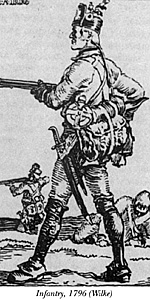 1792 found the regiment back in its
barracks around Vienna, having just returned
from fighting the Turks.
1792 found the regiment back in its
barracks around Vienna, having just returned
from fighting the Turks.
Infantry, 1796 (Wilke)
In the next 24 years, they were to lose 4,863 casualties in 88 battles and smaller actions. Throughout the period, except for a brief time in 1805, the Regiment was divided into 3 battalions of 6 companies, each of about 180 men and a division, (2 companies), of Grenadiers, which since 1796 had formed part of composite Grenadier battalions of 6 companies.
Still wearing uniforms from the Seven Years War, except that the headgear was now the 'Kaskett', (an early form of shako), the Ist and 2nd battalions went to Belgium as fighting intensified in 1793. As part of Prince Wurttemberg's corps, the Ist Battalion stormed the Roer-Berg on 28th February, a significant contribution to the Allied victory at Aldenhoven the following day. Marching on to help in the siege of Mauberg, the Leib battalion distinguished itself at Famars on the 23rd May, by storming the village of Villerspol and holding it against repeated French counterstrokes.
In late August, the 2nd (Obrist - or Colonel's) battalion arrived at the siege of Quesnoi, which fell on the 13th September. The two battalions then joined up and as part of FMI, Clerfayt's corps based themselves on the Sambre during that Autumn. In early November, the French attacked towards Namur, but were beaten back along the whole line. Standing at Post on the 3rd, the Deutschmeister put up heroic resistance under heavy artillery fire. Clerfayt wrote to the Emperor that: 'All officers of the Deutschmeister greatly distinguished themselves by their bravery'.
Emerging from winter quarters in April 1794, the Austrians took the fortress of Landrecy, while the regiment participated in wrecking a French attempt to prevent this, storming the village of Haspres - 4 men won bravery medals in the fierce fighting around enemy earth works. The DM then formed part of the garrison, but hardly had they arrived when a French offensive forced the Austrian field army to withdraw.
There had been no time to put the defences in order and Landrecy fell on 16th July to General Scherer. It was probably only due to this general's efforts that the two battalions did not suffer the fate ordered by the Convention, that all POWs be put to death. Nevertheless, the DM were spread out across France and in the chaos that reigned there suffered great privations. Of the 1400 captured, 500 were never heard of again.
These battalions were still reforming in 1796, when the 3rd battalion marched to Italy to face the French offensive. At Dego on 14th April, Major de le Blavier led them in support of other Austrian troops, on to higher ground on the frontline. Despite the fire they poured into French ranks, the opposition pushed the Austrians back elsewhere and the 3rd battalion found itself cut off and had to retreat under fire suffering 150 casualties and losing nearly 300 prisoners.
The Austrians then fell back across northern Italy, unable to stop Bonaparte's lightning campaign. The 3rd battalion fought well at Lodi, and in early August were joined by the reformed Ist and 2nd battalions to fight at Castiglione, Arcole and Rivoli. While a small detachment aided the defence of Mantua, the regiment again mounted a brave defence of a fortress, only to have to surrender eventually in large numbers - this time Gradiska, which fell on 19th March 1797.
The next two years allowed some respite for the Austrian army. In 1798, the familiar uniform of Austrian troops during the Wars was brought in and the 'Raupenhelm' helmet introduced. Back in Vienna, the "Edelknaben" made good use of the peace. Such was their reputation for late-night carousing that the locals referred to the black rings which develop under the eyes as 'Deutschmeister'!
The War of the Second Coalition began well in March 1799 and the whole regiment returned to Italy. In revenge for 1796, they participated in the recapture of the fortress at Mantua and then marched to join the main Austro-Russian army around Allesandria. On 13th August, the French attacked at Novi. The fighting was fiercest on the Allied right, where the Deutschmeister were posted.
As the French general Joubert arrived to view the position there, a shout of "Feuer" by Korporal Strakate brought a volley from a 12- man DM patrol, which felled the French commander. As the whole Allied line got moving, the Austrians on the right came under very heavy fire, but held on to anchor the Allied victory - 580 DM lay dead or wounded. The DM continued to partake in the victorious Allied advance and distinguished itself in the fighting around Savigliano.
The collapse of the Coalition in October 1799 made the Austrian position precarious and on 21st October, the French attacked at Mondovi. Losing 31 dead, the 1st and 2nd battalions of the Deutschmeister bravely defended the village as part of Colonel von Brixen's brigade until the 26th. The 3rd battalion joined in the series of clashes in the area until the Austrians were finally masters of the theatre on 5th November.
The Austrian success in Italy continued into 1800, with the Regiment fighting at Monte-Legino and storming Monte Fajale. However, Bonaparte's arrival in Italy with the French Reserve Army changed all that. On 14th June, Melas clashed with him at Marengo. Together with the rest of the Austrian army, the DM were celebrating victory and forming pursuit columns, when Desaix's division arrived at 5 p.m. and plunged the Austrians into total chaos, securing victory for Napoleon. Only the determined resistance of the Grenadiers, among them the Deutschmeister division, saved the army from total ruin. The Austrians hastily signed an armistice the following day and left Lombardy.
Fighting resumed in November and the Deutschmeister spent Christmas in battle at Pozzolo, losing nearly 100 casualties in fierce hand-tohand struggles among the burning houses of the village. Only towards evening were they forced to abandon the position under a heavy French assault. Events elsewhere brought the war to an end and the regiment marched back to Vienna and its barracks.
Since 1780, Archduke Maximillian had been the Regiment's Inhaber, but he died in July 1801 - replaced by Austria's greatest soldier, Archduke Charles. With all his other military and political duties, Charles felt unable to carry out the role of the Teutonic Order and C.O. of the regiment. So in June 1804, he passed both offices to his younger brother, Archduke Anton, who held them until his death in 1835.
1805
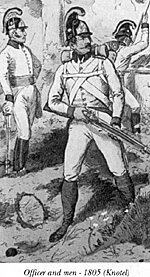 Officer and men - 1805 (Knotel)
Officer and men - 1805 (Knotel)
Archduke Charles carried through many important reforms in the period of peace prior to 1805, including the abolition of the practice of the front rank kneeling to fire in a three- rank volley. Also, powdered hair was abolished, as was the Haarzopf, (ponytail). FML Mack also pushed through a reorganisation on the very eve of war. Under this, the regiment was divided into 4 battalions of four companies and a four-company Grenadier battalion. This produced such confusion that the reforms were swiftly reversed after the disastrous campaign. The regiment only just avoided being involved in Mack's surrender at Ulm on 20th October, receiving the news as it was falling back across Bavaria in the face of Napoleon's Grande Armee.
As part of FML Kienmayer's Army Group, the DM were initially in the area around Steyer at the end of October as part of a defensive line along the Enns river. Falling back further to join the Russians, the troops suffered dreadfully as the weather became ever colder and supplies virtually dried up. One young Ensign even found that the offer of a gold watch could not procure a piece of bread from the locals and at Lunz on the 6th the troops pitched camp in the snow. The following day, on the treacherous road to Neuhaus, conditions were so bad that the artillery train ceased to move.
Under increasing French pressure, the troops manhandled the guns over the high passes - officers all lent a hand, even Major Lazansky, commander of the 3rd DM battalion. The lead units only reached Neuhaus on the following morning and without almost any food for three days, the troops were exhausted. In order to rescue some cannons, FML Merveldt ordered a detachment of Deutschmeister to move back down the hills against the French.
The regiment's commander Baron Engelhardt drew his sword and with the cry "Deutschmeister, follow me", led his soldiers into the fray. FML Merveldtjoined the attack and had to be rescued from capture by Feldwebel Matern. For 45 minutes, the regiment endured a murderous fire from the enemy, but couldn't reach the cannons. Eventually, they were outflanked and had to withdraw back towards Neuhaus. The 5th and 6th companies also found themselves cut off early in the fighting, as the French took Lunz and with the help of a local had to cross the snow-bound 6,000 ft high Durenstein to evade capture.
Falling back on Mariazell, the Austrians continued to be pursued by the French infantry. There the Austrian command feared that the treasures of the famous pilgrim church would be looted.
To gain time for their removal to safety, Oberlemnant Montluisant of the 9th company with volunteers from the regiment mounted a determined defence despite being outnumbered nearly ten-to-one. The treasures were saved and the badlywounded Montluisant received the Knight's Cross of the Maria Theresa Order. The action is now immortalised in a window in the church. The Army Group reassembled around Furstenfeld on 13th November with the DM now only numbering only 1,063 in all - less than a third of its nominal complement. Three weeks later, the campaign ended at Austerlitz.
Although the shako was introduced in 1806, all regiments from the German parts of the empire continued to wear the Raupenhelm, so the regiment embarked on the 1809 campaign in essentially the same uniform, albeit the 1808 pattern tunic had a more angular cut. at the bottom towards the coattails.
1809
 Officer in Oberrock - 1809 (Wilke)
Officer in Oberrock - 1809 (Wilke)
Initially the DM were part of Hiller's VI Korps and arrived on the 20th April north of' Landshut in Bavaria, to find that Napoleon had broke V Korps and split the Austrian army in two.
Napoleon had now turned his force south and had taken position to attack FML Vincent's troops in and behind the village of Rottenberg. The Bavarians were able to move into Mostanerhofe wood and threatened to outflank the Austrian forces on the high ground above the village. It was about 7 p.m. when the Deutschmeister were ordered to attack - in full battle order with flags flying and the musicians playing, they took the wood in the first assault. 300 Bavarians were captured and numerous others killed.
Only when Napoleon himself ordered a whole division forward did the regiment have to withdraw. Despite being pressed to the front and on both sides, 160 volunteers put up heroic resistance, contesting every piece of greenery to allow an orderly withdrawal. In all, 283 casualties were sustained, but some pressure on the retreating forces was removed. However, matters became much worse, as the troops on the Rottenberg-Landshut road met those fleeing from Pfaffenhausen. After the cavalry screen gave way, the Deutschmeister formed the sole line of resistance in front of the town of Landshut and its vital river crossing. Despite fierce resistance, the DM could not stop the French entering the town, and as Mouton's troops took the main bridge into the centre of Landshut, many Deutschmeister found themselves cut off nearly 1150 were captured and the regiment was now down to half its strength.
It was the turn of the Grenadier division to cover the retreat from the town and here one of the most famous episodes of the campaign supposedly took place. Forming the very last cover for Hiller's men, these Grenadiers found themselves cut off in a wood by French cavalry.
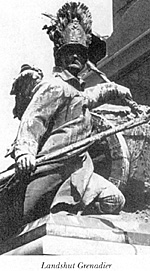 Landshut Grenadier
Landshut Grenadier
Quick as a flash, a Grenadier ran out and fired into an abandoned ammunition wagon. A huge explosion filled the sky and the soldier fell lifeless to the ground - his comrades escaped into the night. Sadly, there is no record of a DM Grenadier being killed in April 1809, but it's a nice story!
The regiment continued to fight a series of rearguard actions as Hiller withdrew towards Vienna, including at Ebelsberg. Most famously, 300 men of the 3rd battalion and 2 squadrons of Hussars under Lt.Col. von Klopstein held up Napoleon's forces at Enns on 4th May for the whole day under continuous heavy artillery fire and various attempted river crossings, so that Hiller was able to organise a crossing of the Danube to rejoin the main Austrian army.
Vienna was of course the regiment's home and its depot troops, many only having received a few days training, were among the city's defenders. Although the capital city quickly fell to Napoleon on 12th May, only 650 men were captured from a total of 2050 many were given civilian clothes by the local people and escaped to join the regiment on the Marchfeld.
Although its Grenadiers participated in the famous Austrian attempts to storm the Granary at Essling over 21st/22nd May, the DM infantry did not take part in Charles' victory at Aspern. With IR49 Kerpcn and 2 Landwehr battalions under GM Mayer, the infantry thwarted various attempts by Lannes to secure a bridgehead opposite Vienna on Schwarze Lacken-au, and remained to guard against further efforts at this point.
As it became clear Napoleon would try again in early July, Mayer's brigade moved down to a position behind GrosEnzersdorf and took the full force of the French attack, as it spread out from the new bridgehead on 5th July 1809. Continuously threatened by cavalry and suffering heavily from canister-fire, the brigade marched back across the Marchfeld and took position on the Austrian left at Markgrafneusiedl. It was here on the 6th that Davout led his famous assault to break the Austrian wing before Archduke Johann could arrive. Under a heavy artillery barrage, the French attacked the village to the front.
Unable to break in, the French also mounted a flanking attack via a crossing over the Russbach stream close to the village. The DM and the rest of the brigade were hastily moved to form a new flank. Led by FML Nordmann, these troops fought a fierce struggle, which flowed first one way and then the other, among the ditches and around the famous tower on the high ground behind Neusiedl. As artillery fire rained in, the regiment fought bravely amongst the wooden houses, many of which quickly caught light.
Despite beating off determined French assaults, eventually the troops could do no more and at 1 p.m., they received the order to retreat. Of the 1,064 who started the battle, 734 were casualties - many of the wounded probably perished in the flames and doubtless many members of the regiment lie among the bones in the church at Markgrafneusiedl.
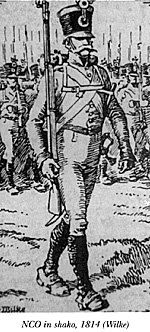 NCO in shako, 1814 (Wilke)
NCO in shako, 1814 (Wilke)
The next few years were a welcome breathing space. In 1810, the regiment finally received its shakos and was fortunate enough to avoid joining the Austrian Auxiliary Corps of 30,000 men, which went to Russia in 1812.
Initially destined for Bavaria, the three field and newly-formed fourth, (Landwehr), battalions returned to familiar surroundings in Italy in 1813, joining in the fighting around Verona in November. At daybreak on the 19th, the third battalion stormed the villages of San Martino and Getto under heavy French artillery fire.
By February 1814, the regiment was fighting on the Mincio river and on the 8th, the Grenadiers again fought at Pozzolo, while the regiment fought at Valeggio. The 2nd and 3rd battalions fought their way up the hills at Monsambano and pushed the French out of the village there in fierce fighting which lasted all day. The first battalion, joined by the redeployed third battalion, then stormed il Furoni. During the closequarters struggle, Lt. Baron Synoth was severely wounded and about to be captured, when Feldwebel Fuchsgruber appeared.
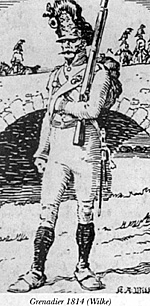 Grenadier 1814 (Wilke)
Grenadier 1814 (Wilke)
With a series of quick, well-aimed shots, drove off the French would be captors and rescued the officer - this episode is known as 'The True Comrade' and exemplifies the highest traditions of the regiment.
In April 1814, the French signed an armistice. Effectively, for the Deutschmeister, the long war was over - in 1815, the regiment moved into southern France, but saw little action.
More 'Hoch und Deutschmeister'
Back to Napoleonic Notes and Queries #8 Table of Contents
Back to Age of Napoleon List of Issues
Back to MagWeb Master List of Magazines
© Copyright 1995 by Partizan Press.
This article appears in MagWeb (Magazine Web) on the Internet World Wide Web.
Other military history articles and gaming articles are available at http://www.magweb.com